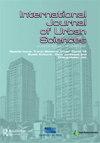How did travel mode choices change according to Coronavirus Disease 2019? Lessons from Seoul, South Korea
IF 3
3区 工程技术
Q2 ENVIRONMENTAL STUDIES
引用次数: 16
Abstract
ABSTRACT The severe acute respiratory syndrome coronavirus 2 (SARS-CoV-2) pandemic is believed to have substantially changed travel mode choices. While current urban transit policies and plans aim at higher public transit ridership, the negative perception that transit is unsafe increases in line with the spread of Coronavirus Disease 2019 (COVID-19) because of its higher risk in cases in which so-called 3C conditions are met: crowded areas, close-contact settings, and closed places. Thus, this study empirically examines how the perception of urban spaces changed by COVID-19 and how it influenced the choice of travel modes, accordingly, in the Seoul Metropolitan Area, South Korea. A structural equation model presents that changes in individual cognition and positive perception of policy changes during COVID-19 changes their perception of multi-use facilities negatively compared to before the COVID-19 outbreak. The negative perception is found to result in changes in travel mode choices by decreasing public transit ridership. Analytical findings show that intrinsic utility (i.e. risk perception) is revealed as a major determinant to understand travel mode choice. Also, in relation to the limitations of the current metropolitan transit system, the findings provide policy implications in the aspect of preventive measures and promoting micro-mobility for post-COVID-19 transit. Highlights The behavioural change under the pandemic is caused by fear of infection. Risk perception on public transit is affected negatively due to COVID-19. The increased risk perception leads to a reduction in public transit use. Risk perception is a major determinant to understand travel mode choice. Promoting micro-mobility will enhance the city's resilience during a pandemic.2019冠状病毒疫情如何改变出行方式?来自韩国首尔的教训
严重急性呼吸综合征冠状病毒2 (SARS-CoV-2)大流行被认为大大改变了人们的旅行方式选择。虽然目前的城市交通政策和计划旨在提高公共交通客流量,但随着2019年冠状病毒病(COVID-19)的传播,认为交通不安全的负面看法也在增加,因为在满足所谓的3C条件(拥挤地区、密切接触环境和封闭场所)的情况下,交通不安全的风险更高。因此,本研究以韩国首尔都市圈为例,实证研究了对城市空间的看法如何因COVID-19而改变,以及它如何影响人们对出行方式的选择。结构方程模型表明,与疫情前相比,疫情期间个体对政策变化的认知和积极感知的变化使其对多用途设施的认知发生了负向变化。研究发现,负面认知通过减少公共交通客流量而导致出行方式选择的变化。分析结果表明,内在效用(即风险感知)是理解出行方式选择的主要决定因素。此外,针对当前城市交通系统的局限性,研究结果在预防措施和促进covid -19后交通微流动性方面提供了政策启示。大流行期间的行为改变是由于害怕感染造成的。新冠肺炎疫情对公共交通风险认知产生负面影响。风险意识的增强导致公共交通的使用减少。风险感知是理解出行方式选择的主要决定因素。促进微流动将增强城市在大流行期间的抵御能力。
本文章由计算机程序翻译,如有差异,请以英文原文为准。
求助全文
约1分钟内获得全文
求助全文

 求助内容:
求助内容: 应助结果提醒方式:
应助结果提醒方式:


